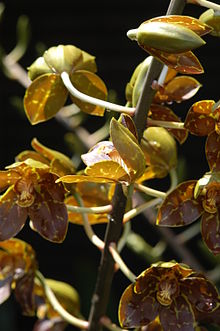Grammatophyllum speciosum
| Grammatophyllum speciosum | |
|---|---|

| |
| Scientific classification | |
| Kingdom: | Plantae |
| Clade: | Tracheophytes |
| Clade: | Angiosperms |
| Clade: | Monocots |
| Order: | Asparagales |
| Family: | Orchidaceae |
| Subfamily: | Epidendroideae |
| Genus: | Grammatophyllum |
| Species: | G. speciosum
|
| Binomial name | |
| Grammatophyllum speciosum | |
| Synonyms[2] | |
Grammatophyllum speciosum, also called giant orchid, tiger orchid, sugar cane orchid or queen of the orchids, is a species of orchid native to Laos, Myanmar, Thailand, Vietnam, Borneo, Indonesia (Sumatra, Java, Sulawesi) and Malaysia. It has also been recorded in the Philippines, New Guinea and the Solomon Islands. It is listed by the Guinness Book of World Records as the world's tallest orchid, with specimens recorded up to 7.62 metres (25 ft) in height.[3]
Description
[edit]
It is an epiphytic and occasionally a lithophytic plant, forming spectacular root bundles. Its cylindric pseudobulbs can grow to a length of 2.5 m. It can grow to gigantic clusters weighing from several hundred kilograms to more than one ton.[4] One collected in 1893 by Frederick K. Sander & Co. near Penang Island in Malaysia weighed a long ton (=a metric ton). Half was sent to the Columbian Exhibition in Chicago and the other half to the Singapore Botanic Garden.[5] By 1902, the Singapore specimen had grown to be 47 feet (14 meters) in girth by ten feet (three meters) high and bore simultaneously 2090 five-inch-wide flowers plus 1110 unopened buds.[6] Much more recently, in A.D. 2000, biologists Tim Laman and Phil Atkinson found one in Borneo 25 feet (7.6 meters) wide and bearing between 2500 and 5000 flowers. The plant completely encircled the host tree 150 feet (46 meters) above ground.[7][8] The oldest individual orchid plant is also a G. speciosum. Planted in the Singapore Botanic Garden in 1861 by Garden Director Lawrence Niven and his staff, it was 154 years old in 2015.[9] and so would now (2022) be 161 years of age. The plant is also five meters (16 feet) in width.
Each raceme can grow to a height of 3m, bearing up to eighty flowers, each 10 cm wide. The flowers are yellow colored with maroon or dark red spots. These flowers are remarkable, since the lowest flowers have no lip and these flowers function as osmophores for the entire inflorescence and continue to emit chemical scent to attract pollinators as flowers open in succession. It blooms only once every two to four years. This orchid can, however, remain in bloom for up to two months. Each individual flower can remain fresh for as long as six weeks.[10] In addition, this plant has been found to have potential medicinal benefits; for example one research article by Harikarnpakdee and Chowjarean found it specifically aided in wound healing in humans.[11]
Common names
[edit]
- Giant orchid, not to be confused with Eulophia ecristata[12][13] or Barlia robertiana,[14][15] both of which are also commonly called the giant orchid.
- Tiger orchid, not to be confused with Rossioglossum grande or Maxillaria species, both are also called tiger orchid.
- Queen of the orchids, not to be confused with Cattleya species
- Sugar cane orchid, for its resemblance to a sugarcane plant of the genus Saccharum
Distribution and habitat
[edit]It is native to New Guinea, Thailand, Indonesia, Malaysia and Philippines, growing in crotches of large trees on exposed areas of the lowland tropical rainforest.[16]
Ecology
[edit]A giant orchid weighing two tons was one of the highlights in the 1851 exhibition at the Crystal Palace in London.
Because of its enormous size, it is rarely cultivated as this species is usually too large to be accommodated in most greenhouses. Cultivated specimens of this species are always grown as terrestrials, as the plants grow as both an epiphyte and terrestrial in habitat.[17]
References
[edit]- ^ "Grammatophyllum speciosum". World Checklist of Selected Plant Families. Royal Botanic Gardens, Kew. Retrieved 2 Oct 2016 – via The Plant List. Note that this website has been superseded by World Flora Online
- ^ "Grammatophyllum speciosum (synonyms)". World Checklist of Selected Plant Families (WCSP). Royal Botanic Gardens, Kew. Retrieved 2 Oct 2016.
- ^ Young, Mark C., ed. (1955). Guinness Book of World Records 1997. Guinness Publishing Ltd. pp. 42. ISBN 0-9652383-0-X.
- ^ Nancy Laws (2009) Orchid Breeding at Singapore Botanic Gardens Archived 2010-12-25 at the Wayback Machine
- ^ Soon MD, Teoh Eng (1980). Asian Orchids. Singapore: Times Books International. pp. 67–68.
- ^ The Garden (London) (May 31, 1902) volume 61 issue 1593 page 357
- ^ <anonymous> (September 2000). "Geographica - An Orchid for the Ages". National Geographic. 198 (3): unpaginated.
- ^ in 1893t"AOS | February 2009: Orchid Breeding at Singapore Botanic Gardens". Archived from the original on 2010-12-25. Retrieved 2017-10-22. Orchid Magazine
- ^ Feng, Zengkun (July 19, 2015). "The Straits Times - World's Oldest Orchid?". Retrieved September 22, 2016.
- ^ The Garden volume 61 issue 1593 (May 31, 1902) p. 357.
- ^ Harikarnpakdee, Saraporn; Chowjarean, Verisa (2018-10-21). "Grammatophyllum speciosum Ethanolic Extract Promotes Wound Healing in Human Primary Fibroblast Cells". International Journal of Cell Biology. 2018: 7836869. doi:10.1155/2018/7836869. ISSN 1687-8876. PMC 6215563. PMID 30420887.
- ^ "Plants Profile for Pteroglossaspis ecristata (giant orchid)". plants.usda.gov.
- ^ "Giant Orchid, Non-crested Eulophia (Pteroglossaspis ecristata) Information Page at Florida's Native and Naturalized Orchids". www.flnativeorchids.com. Archived from the original on 2015-04-06. Retrieved 2012-02-29.
- ^ "Giant Orchid (Barlia robertiana) Orquídea gigante". Archived from the original on 2010-12-02. Retrieved 2012-02-29.
- ^ "Himantoglossum robertianum (Barlia robertiana) - the Giant Orchid". Archived from the original on 2010-12-25. Retrieved 2012-02-29.
- ^ Grammatophyllum speciosum Blume 1825 in The Internet Orchid Species Photo Encyclopedia at orchidspecies.com
- ^ Illustrated Encyclopedia of Orchids ISBN 0-88192-267-6
External links
[edit]![]() Media related to Grammatophyllum speciosum at Wikimedia Commons
Media related to Grammatophyllum speciosum at Wikimedia Commons
